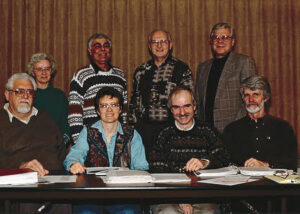Are our Mennonite institutions an endangered species? Are they headed for extinction in this post-Christian era when the emphasis seems to be more on “spiritual” than “religious”?
Do our area church and national church leaders quake in their boots when they hear Stuart Murray observe that Christianity, the dominant world religion for 17 centuries, is being pushed to the margins? Or, more specifically, when Willard Metzger, MC Canada’s executive director, tells MC British Columbia delegates gathered for their annual gathering that in Britain both the Methodist and Presbyterian communions have made burial arrangements for their deaths 25 years from now?
While the warning signs are there, let’s not write our own obituary just yet.
Having wrapped up my visits to three area church annual gatherings, I would say there is considerable life left in these organisms; indeed, there are signs of renewed energy on several fronts.
Our camps, struggling with the right ownership/business model for survival, provide an important rite of spiritual passage for our young people. In the natural beauty of these outdoor settings—where campers feel closer to their Creator—having a place to escape from smart phones and computers, while experiencing the modelling of adult counsellors and the intentional efforts at spiritual formation at this crucial stage of adolescent development, are worth every dollar invested.
And speaking of entry points, the area church serves as a welcoming agent for new ethnic churches from around the globe that are finding a home in the Anabaptist tradition. This is enriching our European-based culture with new dynamism and a reminder of the “first-love” many of us felt as new Christians. To see the radiant smiles of these persons as they fill the stage in welcoming rituals is spine-tingling.
And how better to finesse and hone our collective vision as congregations than to hear keynote speakers such as Murray, who, despite dire warnings about our future, reference the ancient prophet Isaiah telling us to figuratively “build houses, have children and plant vineyards,” even though we might feel at times that we are in exile.
And then to have that same hope echoed across the country by Dan Epp-Tiessen in Leamington, Ont., in his keynote address to MC Eastern Canada delegates, when, teaching from the Book of Daniel, issued the challenge to “know who we are so that we can stand up to ‘empire’ when our faith faces the fire.”
Or to hear Metzger tell Manitoba delegates about an increasing attraction to Anabaptism, especially among the young-adult population. “I tell you,” he said with some passion, “the Spirit of God is moving. The voice of the Lord is being heard. If we do not lift up the Anabaptist understanding of the gospel, others will gently take it from us and live out its call to radical discipleship without us.”
Where will new congregations and pastors get the resources for capital projects and development, for resolving conflicts, for new pastors discerning their call and ongoing nurture, or for help to plan for credentialling, without the help of area and denominational ministers?
All these are gifts to the congregation that are often underestimated, sometimes ignored. They shouldn’t be. Rather, they should not only be recognized and paid for gratefully, but celebrated for the high value and energy they bring to our faith communities.
Unfortunately, these are too often seen as tools with expensive price tags, rather than life-giving essentials for growth and development. We look at deficit budgets as a cross to bear and an incentive for cost-cutting, rather than a call to greater commitment. It would be much more inspiring if our treasurers could be proposing exciting new innovations, rather than timidly reporting diminishing numbers.
There is hope. This year, two out of the five area churches reported budgets in the black; the others have plans to live within their means. And we, as investors, should balance our holding these institutions accountable with a word of encouragement to those who work to make the best use of these dollars.
With our Anabaptist DNA, birthed out of a protest movement to religious institutional corruption, we tend to view our own institutions as prone to corporate sins, but in a “priesthood,” we are members one of another. We are not endangered as long as we treat each other as “priests.”








Leave a Reply
You must be logged in to post a comment.